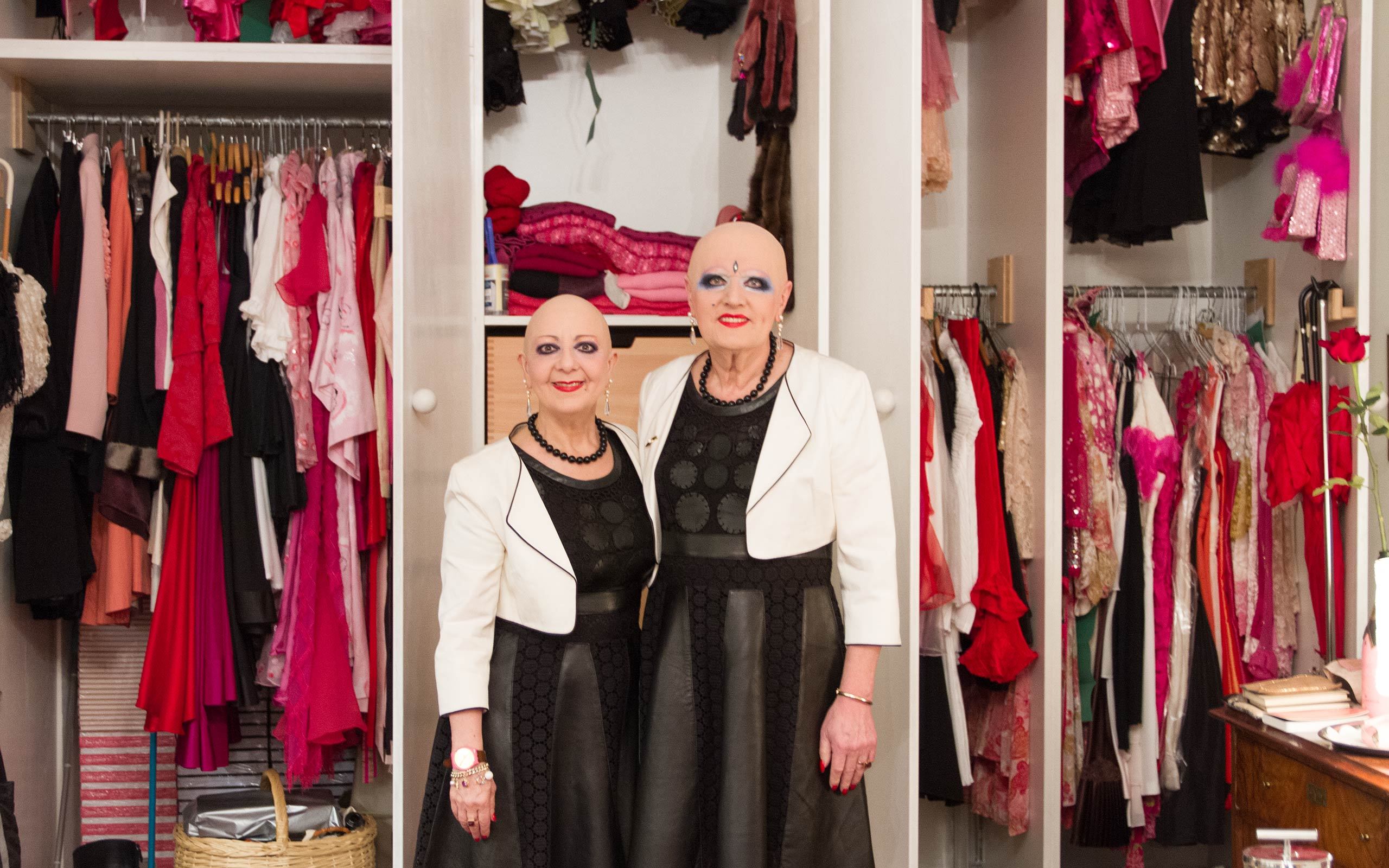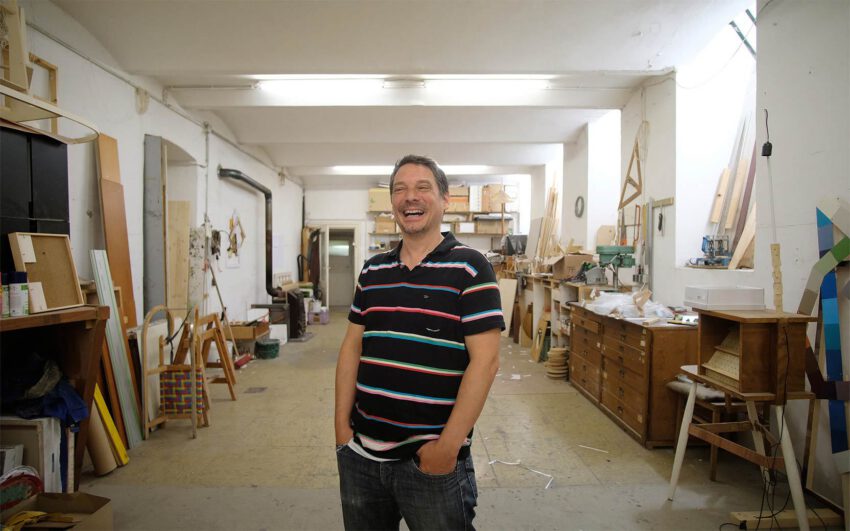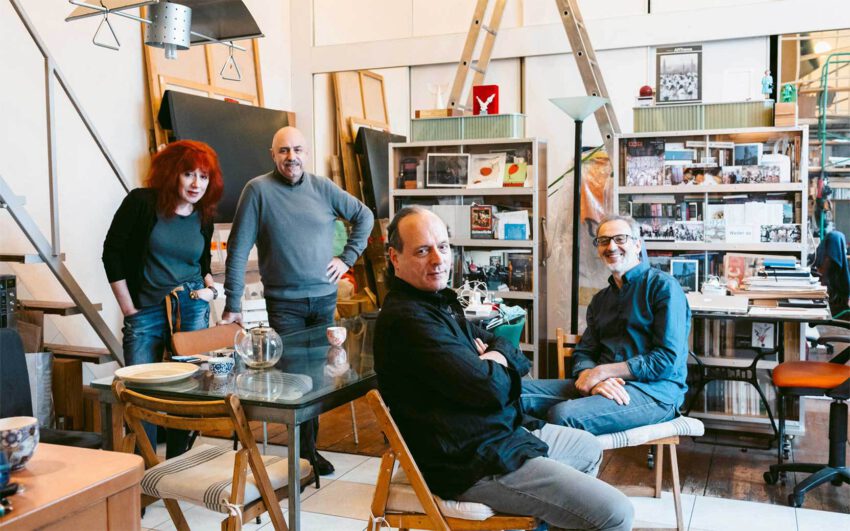Self-proclaimed "hermaphrodite twins from the future", EVA & ADELE have turned their life and partnership into a Gesamtkunstwerk. The duo makes appearances at galleries, fairs, and other art world events stealing the limelight with their extra-terrestrial looks and extravagant frocks. Wherever we are is museum, runs one of their catchphrases, which implies that the two of them never cease to be EVA & ADELE – 24/7, 365 days a year. We spent an afternoon for an intimate conversation with them in their studio and home in Berlin-Charlottenburg, during which we discovered two exceptional and charming persons. Among others, we learn about the private life of EVA & ADELE, how they really met, and about the one or other surprise about Berlin’s probably oddest couple.
How did EVA & ADELE find each other?
E: Imagine it along these lines: when we found each other we were coming from the future and were on our way to ancient Greece. We actually met in the future, in the time machine, traveling to the roots of European culture in search of Hermaphrodite.
A: Making the film, we moved through very lonely landscapes for a very long time – so remote that we didn’t even hear that the Berlin Wall had fallen in the meantime.
E: It was a very wonderful journey. We were spending our nights on location. Often we stopped filming with the last rays of the sun only to continue in the early morning sun. We traveled in our former VW Camper. When the film was complete, we continued this life in our present appearance with shorn heads and in costumes; we’ve continued all this in our real life until today.
A: This film dating from the fall 1989 has the title Hellas and can be described as the becoming or actual “getting to know each other” of EVA & ADELE.
At that time you weren’t really EVA & ADELE?
A: No, we had not yet made the decision. We might have been EVA & ADELE at the time, yet we weren’t aware of it. Art is faster and perhaps more intelligent than we are. In 1991 with a performance in which we represented two brides, we officially decided to become EVA & ADELE.
Since 1991 you have been known as EVA & ADELE, who always appear together and can often be seen at vernissages and cultural events.
A: We’ve both performed prior to that but in different costumes; they were not identical but coordinated artistically following concepts of painting and sculpture. Since 1991 we began wearing absolutely identical costumes. We consider April 11, 1991 and the Performance Wedding Metropolis our birthday.
Would you share how you met?
A: We were both attending at the same time, an artist symposium in a small village in Umbria. I worked there. Eva had come to visit friends. I wasn’t happy with the evening of the farewell party. It was a classic example of such an occasion with many macho heroes and I was thinking “Oh my God”. I’ve always loved dancing and that night one of these guys approached me saying “I lead.” And I thought that’s just what I need (laughs). Then we danced. Today I am aware that this dance foretold so much. While we were dancing the lead went back and forth between us...
E: … for six hours, without interruption! At some point, the musicians had collapsed over their instruments, sleeping, but we continued dancing!
A: During that long dance we learned much about each other and our future collaboration. We dared risky jumps catching each other.
E: It was very important that at this time we still had a neutral outer appearance.
A: Well, neutral is different (laughs).
E: I wore white Marlene Dietrich pants, silk stockings underneath, was dressed rather bisexually.
A: You were also beautifully made up and had painted finger nails.
E: Yes, everything was quite ambivalent.
A: That’s true.
How did this first evening end?
E: When we noticed that everyone had gone and we were alone, we set out for Adele’s apartment. We were passing my car, our former VW Camper, in which I lived at the time. I opened it and picked up a box and asked Adele to open it. It contained a lot of Polaroids, self-portraits in various female roles that I had performed with changing hair colors and other changing elements. And when Adele reacted positively, I went with her.
A : Fortunately!! In the early 1990s, we have changed the VW Camper’s lacquer to pink and mounted our sign “EVA & ADELE, Global Artwork” and our logo on it. In 2000 the pink camper was included in the collection of the Sprengel Museum in Hanover as Biographical Sculpture No. 2.
Are there still journeys like the one to Greece?
E: Yes, they are still happening. On these journeys in the camper we took many Polaroids of our faces and clothing, which are inspired by painting. These Polaroids document our performative “going out” or our “becoming public.” Between 1991 and 2005, we repeatedly took Polaroids for financial reasons unfortunately not every day but only on special days.
A: The journeys have changed. Ever more often we retreat to small islands in France and on the Baltic Sea. There we walk a lot, talk to each other, and draw, conceptual sketches have developed there. Many of these sketches that emerged en route have been shown among other places at the Marta Herford in 2013. During our trips we discuss what’s going on in the studio.
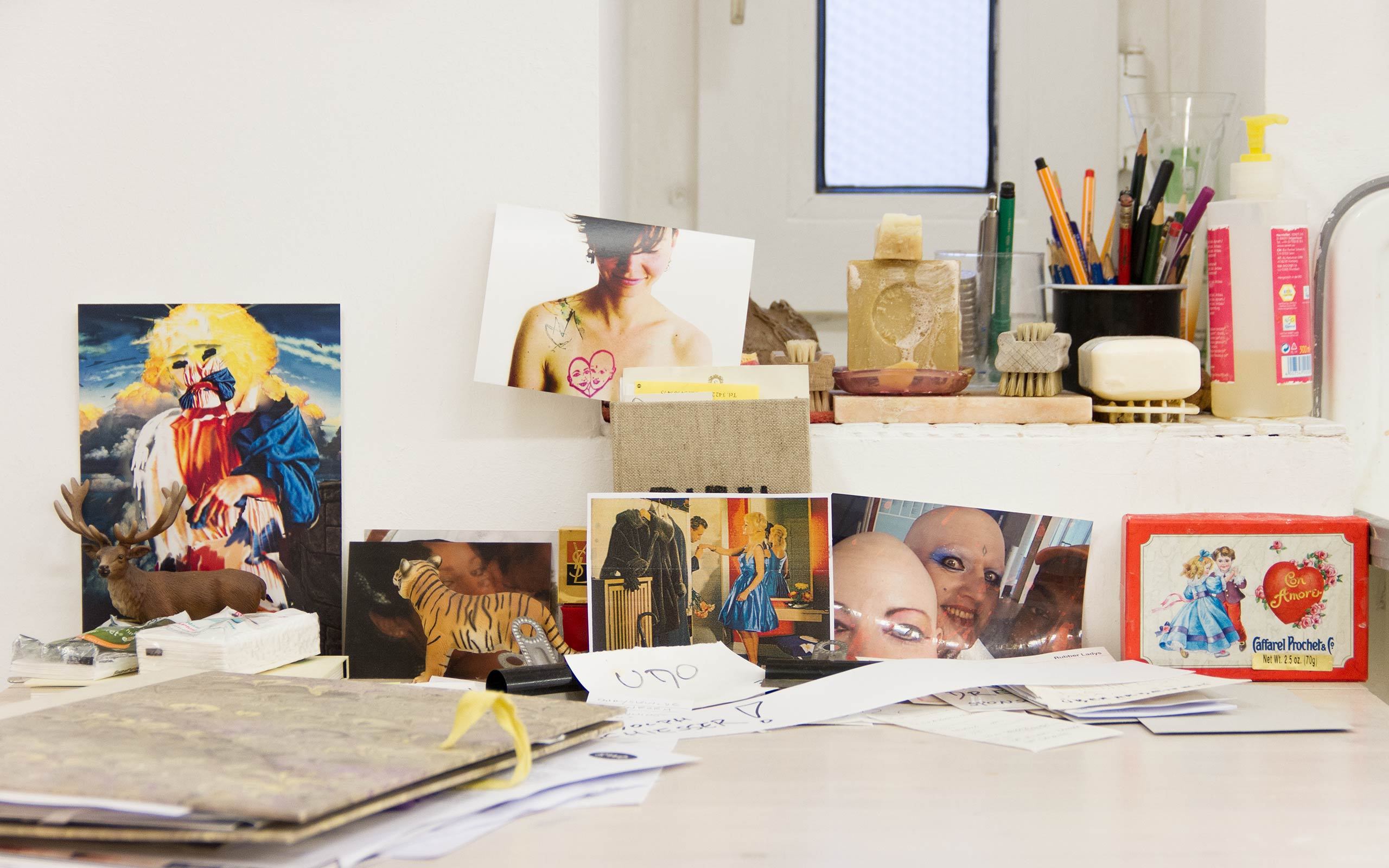
Most people know you from public appearances at art exhibitions and vernissages where you get a lot of attention and are photographed. Your photographs generate a very special dynamic in public, inasmuch as your image is further disseminated. Was it intentionally planned this way?
A: We’ve delegated the documentation of the performance to the audience, without a specific contract. The audience photographs spontaneously and we ask that they mail us a print. This was before the time of mobile phones.
E: Regardless of whether we appeared or traveled the media always followed us, often faster than we traveled ourselves. We were published in big newspapers, which surprised us and made us happy. We recognized very early that an autonomous work was beginning to emerge.
A: The dissemination of pictures as a work of art!! We appear in various categories ranging from culture to miscellaneous. Our image has always worked toward contemporary art. Mediaplastic is our neologism and in our understanding concerned with the expanded concept of art, Beuys’ so-called social sculpture, in the sense of the concept of an ephemeral sculpture.
And it worked? Were these photographs actually sent to you?
A: We have received many photographs, a huge archive has been created.
E: Of course, we have to talk a lot, especially at large events. During the Biennales we handed out a short texts so to inspire people to mail us their photographs. Unfortunately only a small percentage of them responded. We’ve always been clear about the fact that the quantity of pictures was not important, but that they are in the world. It became interesting when we realized that behind every picture the photographer became visible. We’ve stored all the photographs in envelopes.
A: This CUM photograph collection is a huge historical document. Since 1991, we have collected photos from people, with commentaries, with letters, with envelopes from all over the world and now we include digital images and have recently added selfies, mostly as threesomes and as groups (laughs)!
Looking around in your studio your work is obviously much more multidimensional than the performance part in the public space.
A: Yes, that’s very confusing for people but great for us. As an artist you create a work that is completely permeated by your thinking, feeling and the events that happen in your time. This also concerns the gender debate, our gender crossing that many people can’t take, there’s no compartment for it.
E: Many are surprised that we have exhibited paintings. At the Biennale di Venezia for example we showed six Target paintings and many people were completely irritated by that, yet at the same time excited to learn that we also paint.
In your opinion EVA & ADELE have not been completely accepted as a Gesamtkunstwerk in the public awareness?
E: Yes, one could say so. Because of the fact that we performed so much at art fairs we received offers from galleries. However, we intentionally resisted the temptation. Where others have grabbed the opportunity instantly and burned out, we’ve resisted and slowed down.
A: To us it was and still is important that after performative periods in public we take time to retreat into the studio. We are really not as extrovert as our appearances might suggest. We enjoy being alone and private, resembling classical artists who like to be left in peace and work in the studio. The first moments of a performance are always a bit awkward. However, it was our deliberate decision to dare to step out of the studio. Many people haven’t understood that yet up until this day, it is therefore extremely important that we continue with painting.
E: We have developed larger work blocks that have not yet been shown in public. Over the years, very different groups of work developed almost simultaneously in the studio. Sometimes we showed something else in order to move slowly towards that which was developing and consuming so much time in the studio. Therefore we can do larger exhibitions now and hopefully excite wider audiences.
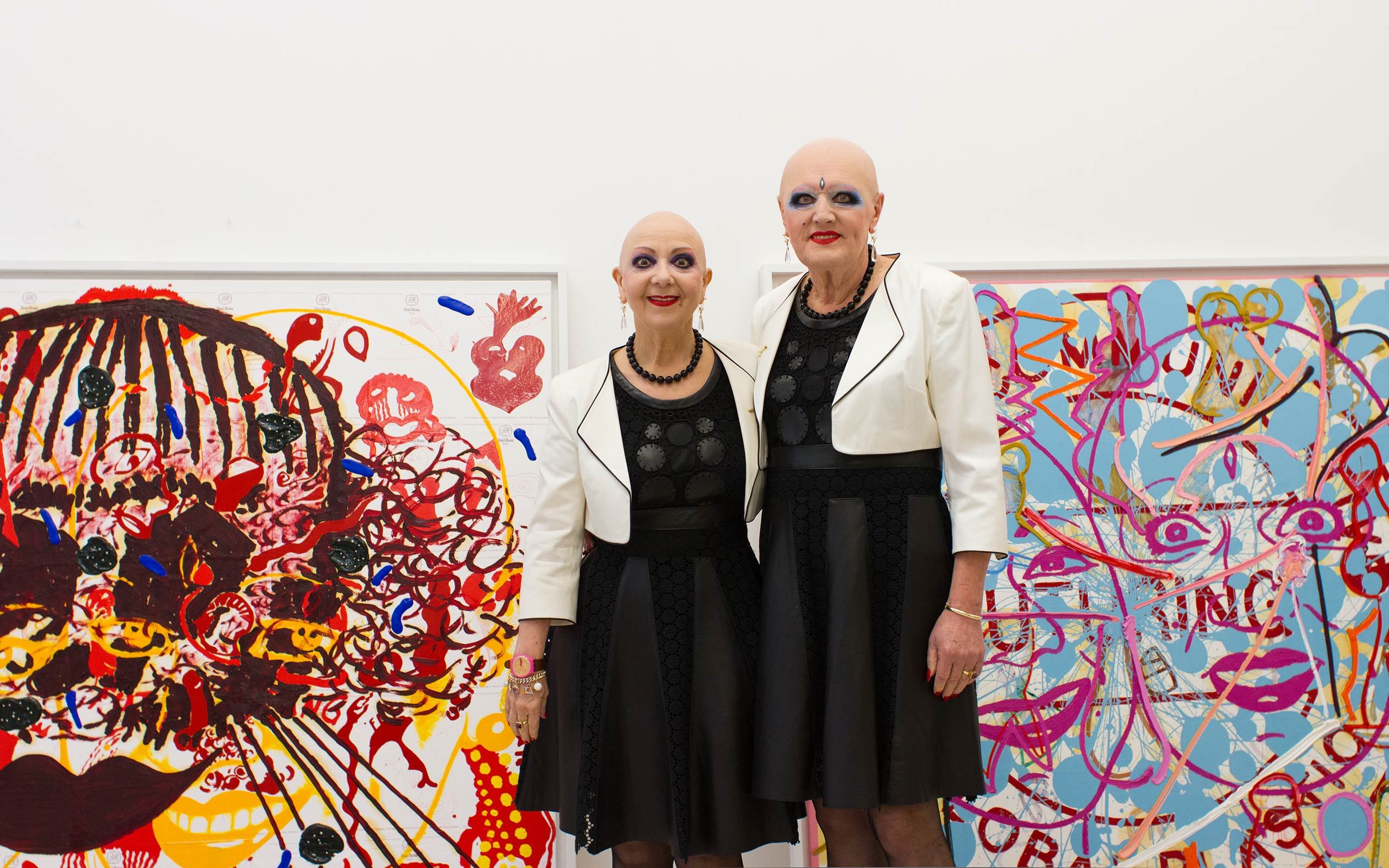
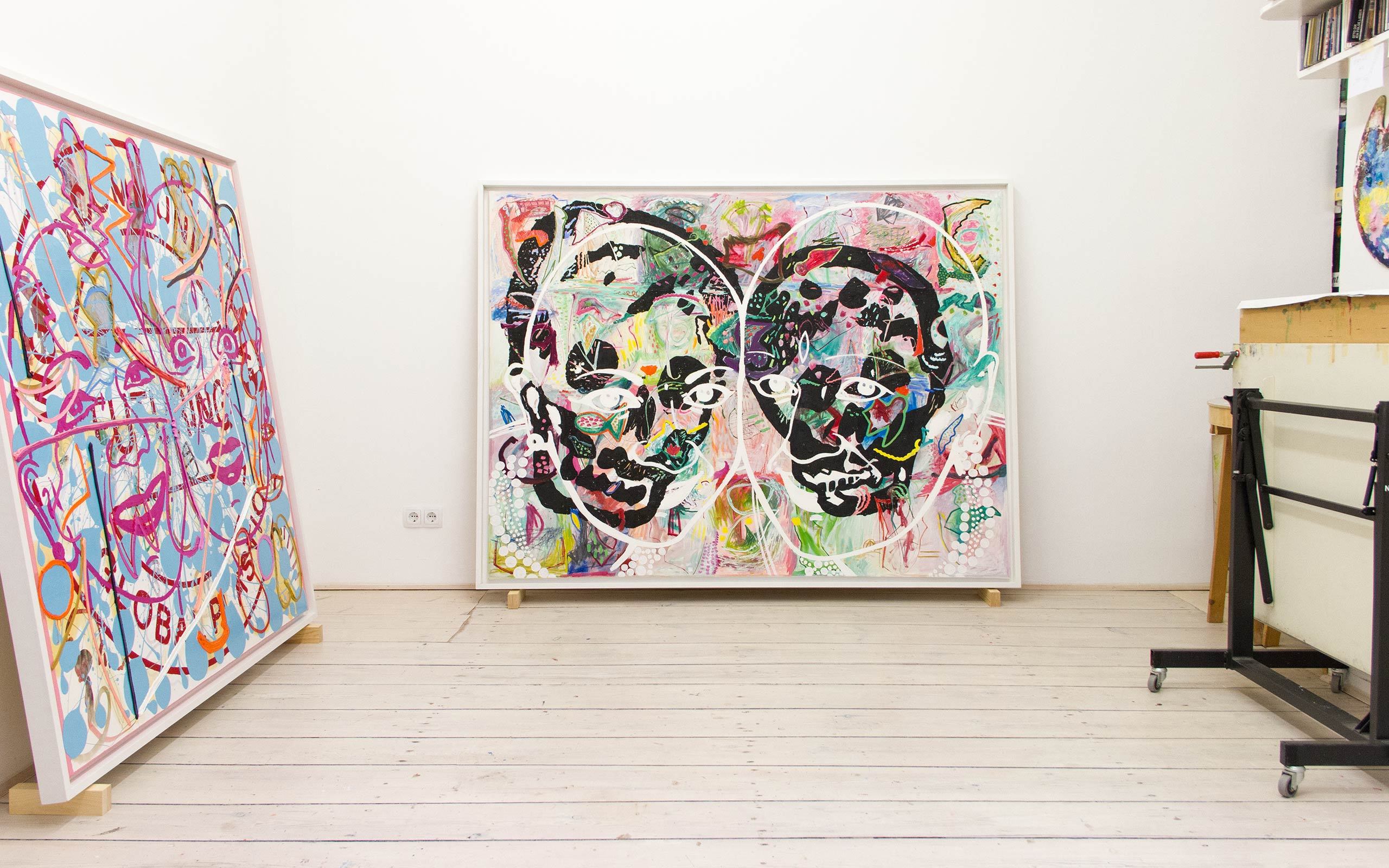
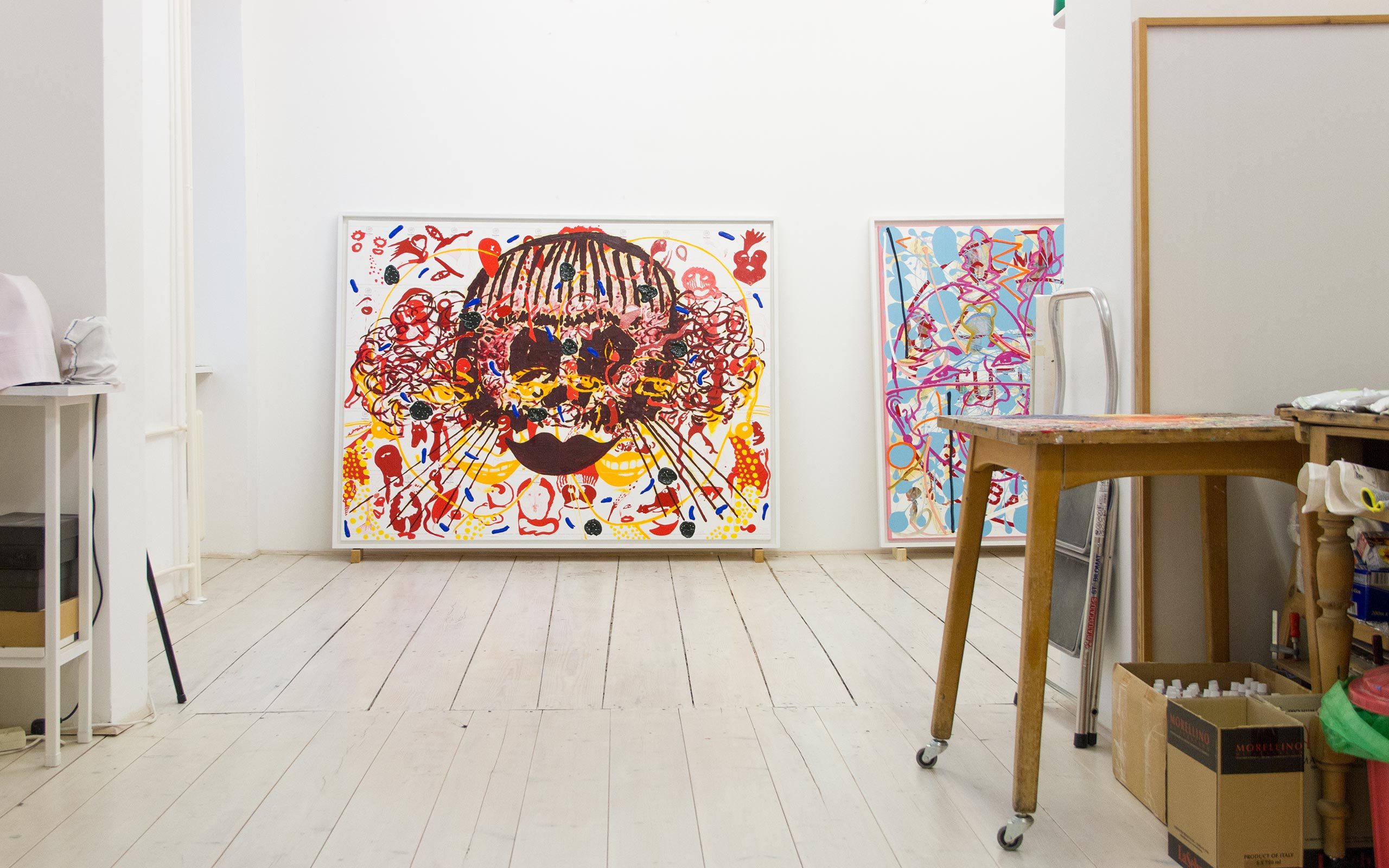
Some artists, especially when they are well established, go to the studio once or twice a week, the rest is done by assistants. But that is not case with you, is it?
E: We assist each other (laughs). Since we became EVA & ADELE, we haven’t taken a vacation. Our travels are often extremely intense work phases, and yet everyone wishes us nice vacations (laughs).
Is there something like EVA & ADELE on vacation?
A: Well, yes. I actually love the word vacation although it doesn’t apply to us. Yet I love the word. When we retreat to the small island in the Atlantic everyone wishes us a nice vacation. And there’s nothing wrong with that. Vacation places always have some kind of vacation atmosphere. That’s alright. The island has a very extensive sandy beach and we walk every day, at least twenty kilometers.
E: A combination of nature and studio. Our camper is a moveable studio and at the same time we are intensively in nature and on the beach. We enjoy that regardless of whether we are seen or not. It is almost a ritual for us to create our appearance in places close to the sea and then to step out and walk against the wind.
A: I have to point out that there our makeup is not as precise as the close-up makeup now; it is applied more thinly, we wear sun glasses and often even head gear.
E: There is no difference for the viewer. When we participate in large events, we apply the makeup very sparingly because it can happen that we have to wear it for a very long time. It once happened on our return flight from Miami Beach via Paris to Berlin that we had a long stopover in Paris, the airport was closed because of heavy snow. Eventually we landed in Berlin after a 36-hour delay, 36 hours in makeup! We looked into the mirror critically and decided that we could attend an opening. We expect from this picture that it will last for the time needed. This requires a very subtle application as with the layered paint in Renaissance pictures.
A: During our last sojourn on the island we had decided to take along nothing but literature, we only wanted to read, not draw. We had really decided to spend a lot of time in the fresh air.
E: We had a need to take a vacation, to read a little, to go for walks. The closer we came to the island, the faster we became. As a precaution we bought drawing utensils since we had taken nothing else along.
One can well imagine that your present success did not fall from the sky. You’ve always worked very hard for it.
E: Yes, one can really say that. We have developed our own path not following the entrenched structures of the art market, we also had to invest a lot.
A: But we’ve also utilized the entrenched systems. That was unavoidable because we want to place our art in important museums and good collections. Our enormous investment has been successful for eight large canvases from the Transformer-Performer group have been purchased by museums; that’s a good result. It is also good that since 1991 we were able to live exclusively from the sales of our art, especially the drawings, and the fees for our performances. Initially, we sold many drawings to friends and acquaintances to support ourselves. But we have also worked with galleries that have promoted and supported us.
E: We have always been careful not to expose ourselves to financial pressures for it impedes on one’s freedom. It was very difficult to do but we managed.
A: Two years ago we made a sale of twenty large paintings to an individual collector for one million euro.
E: The second group Mediaplastic.
A: The very early ones from the first group will be shown for the first time beginning September 29, 2016 at the Musée d’Art Moderne de la Ville de Paris.
How does one million euro affect EVA & ADELE?
A: It was great. We’ve used the money to create a “safety net” to provide us with security for when we hopefully get very old.
E: It has given us more freedom. We now have the feeling that we can go on more forcefully. Two Swiss curators, however, asked us if we would retire. We were shocked that they could think that way.
A: If one had told me earlier that everything would change after such a big sale, I would have opted strongly against it. I’ve always believed in a kind of natural law: those who sow will reap. With our performances and with our drawings and paintings we have achieved a lot as artists. Even if many people have not seen it yet, we know it. But since we have security, this safety net, I joke more. I would never have believed that the first million would make such a difference, but it has added a lightness to our lives.
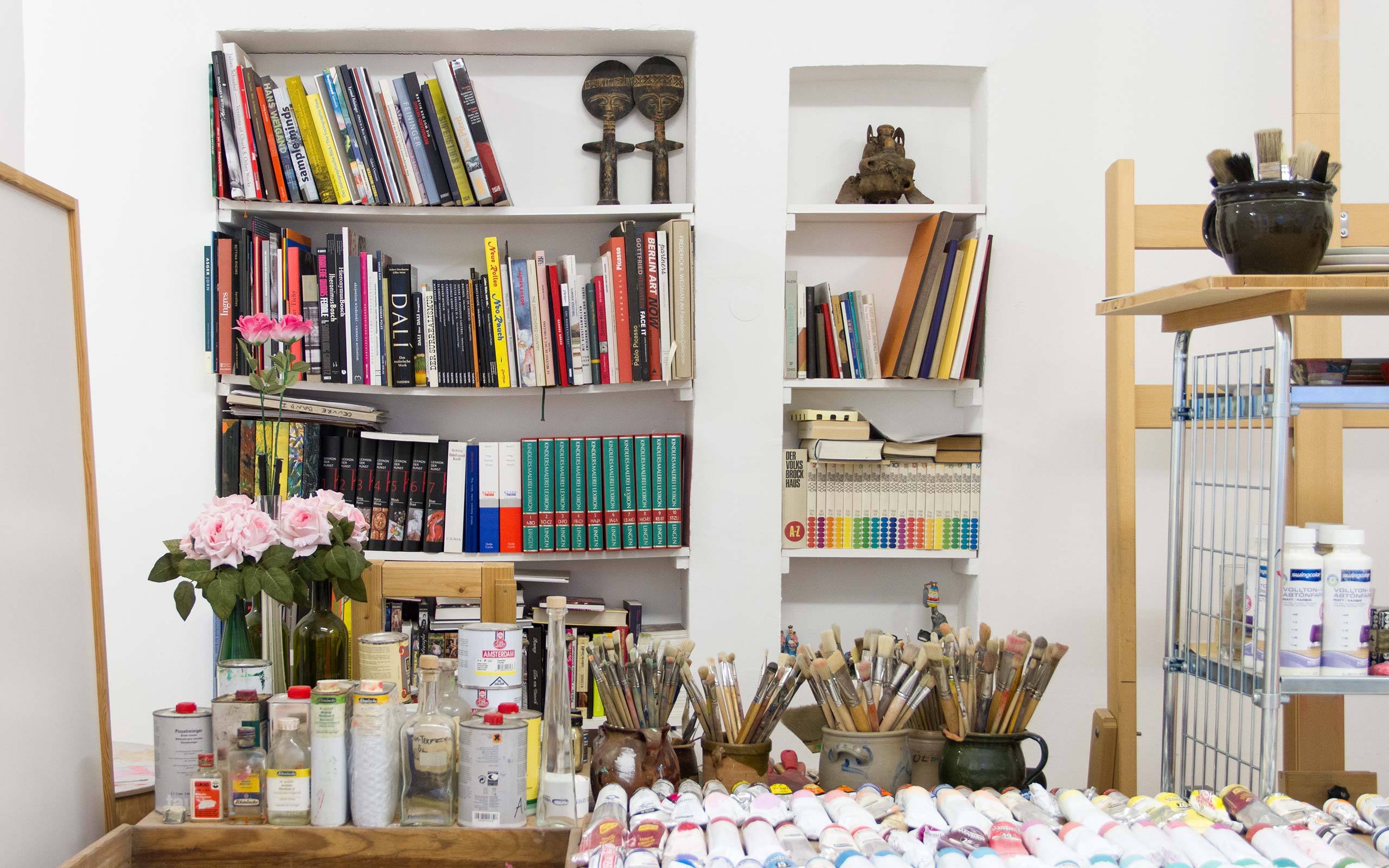
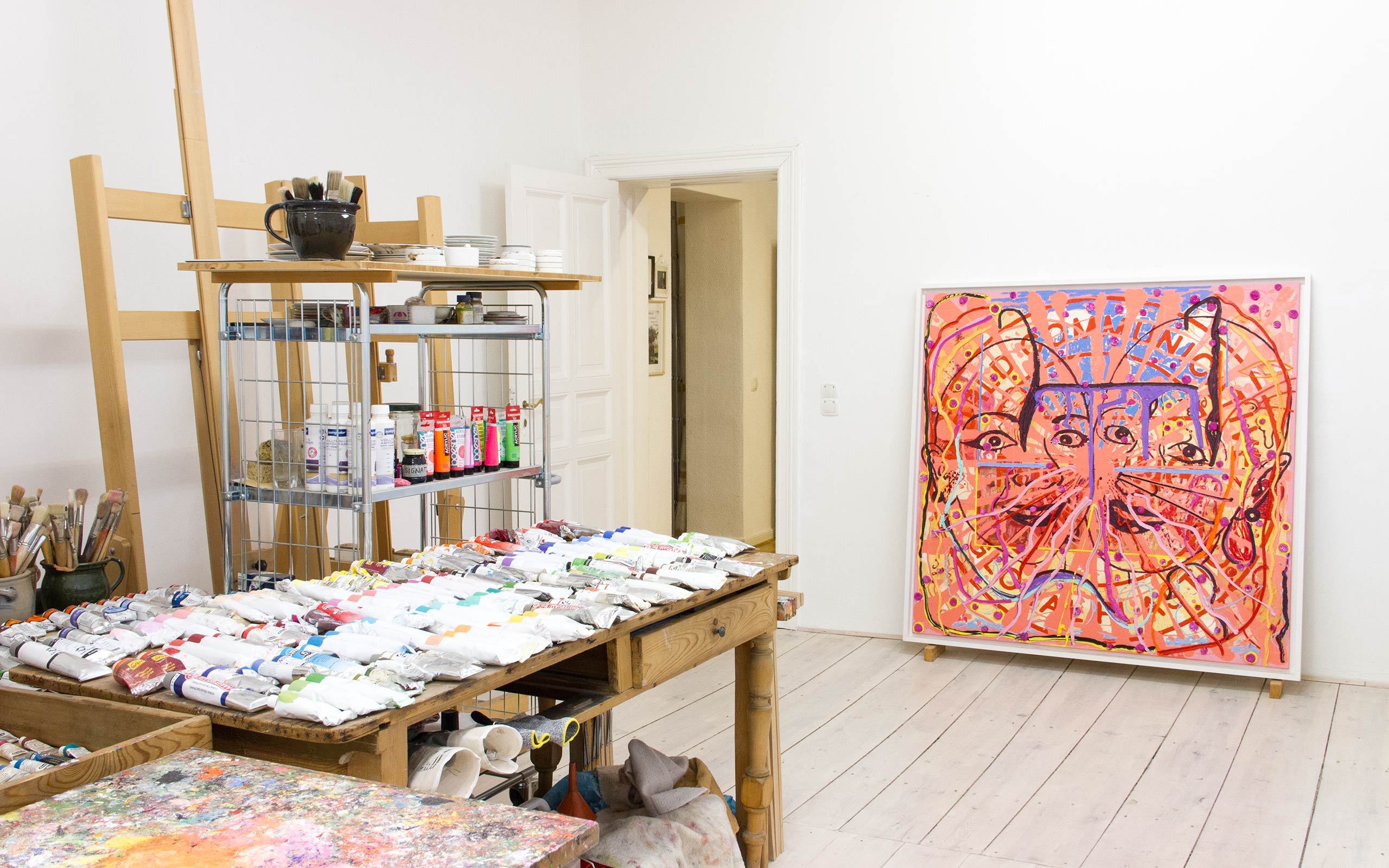
Neither of you are born Berliners, would you call Berlin home?
A: Yes, Berlin is our home. It has a large social scene with many artists whom we know, whom we meet at art openings and with whom we have an exchange. Our apartment and our studio are situated in the vicinity of the Deutsche Oper the artistic director of which is a friend of ours. We attend a lot of premieres and meet opera and music friends. In 1989 Berlin had attracted us completely. Even with the wall Berlin was the freest city in the German-speaking world. We moved to Berlin right after we met. We knew we wanted to be here although we did have a problem with the wall; it was disturbing.
You say of yourselves, “Where we are is a Museum”. Which means that you are always keeping up the performance of EVA & ADELE?
E: Exactly. We never cease being EVA & ADELE – 24 hours a day, 365 days a year, year after year, for twenty-five years now.
A: Our work contains the most varied media, including performance and direct communication. This is also associated with risk. We never know, who we have in front of us. It is an absolutely insecure terrain and can change at any time. We take a maximum of risk moving without any protection in public. Whether we visit our camper on the outskirts of Berlin by S-train, or pick it up or take it to the garage, whether we go somewhere by subway, we never know what’s going to happen, what’s going on with people, what in them we are triggering.
Haven’t you been once attacked because of your appearance? The world is unfortunately not always tolerant.
A: Yes, we have had one confrontation but were able to control it. Many people who want to get rid of their aggressions don’t count with the power we have and need to have. We’re aggressive, we look them directly in the eye showing that they can’t mess with us. We smile and look firmly. The smile and the direct look are weapons. Very few people can endure a direct look. When we were still living in Schöneberg, we had one encounter: four really dark figures walked behind us and we thought shit. We didn’t try to get away quickly, but stopped in front of our door and smiled at the four. They returned our smiles and one of them said, “these two are really cool.” (laughs)
E: We could’ve been beaten up by them. Since we lead a performative life we have to think about how we can protect ourselves, how we can master situations. We have to be very awake, fully alert.
A: One should never quarrel on the street. Others notice it instantly, this too we have learned over the years. Maybe other people are careful as well but they are not as aware. Our awareness of art, life, love, quarreling, reconciliation, about everything has sharpened enormously. Due to the fact that we wanted to keep our performative work at its height, we had to reflect a lot.
Apart from the risk that you continuously confront, it must be very demanding being EVA & ADELE consistently.
E: Yes, it’s very strenuous. We have to be extremely conscious of our time, have to be very aware of how to take care of ourselves, how to get rest because everything requires so much force.
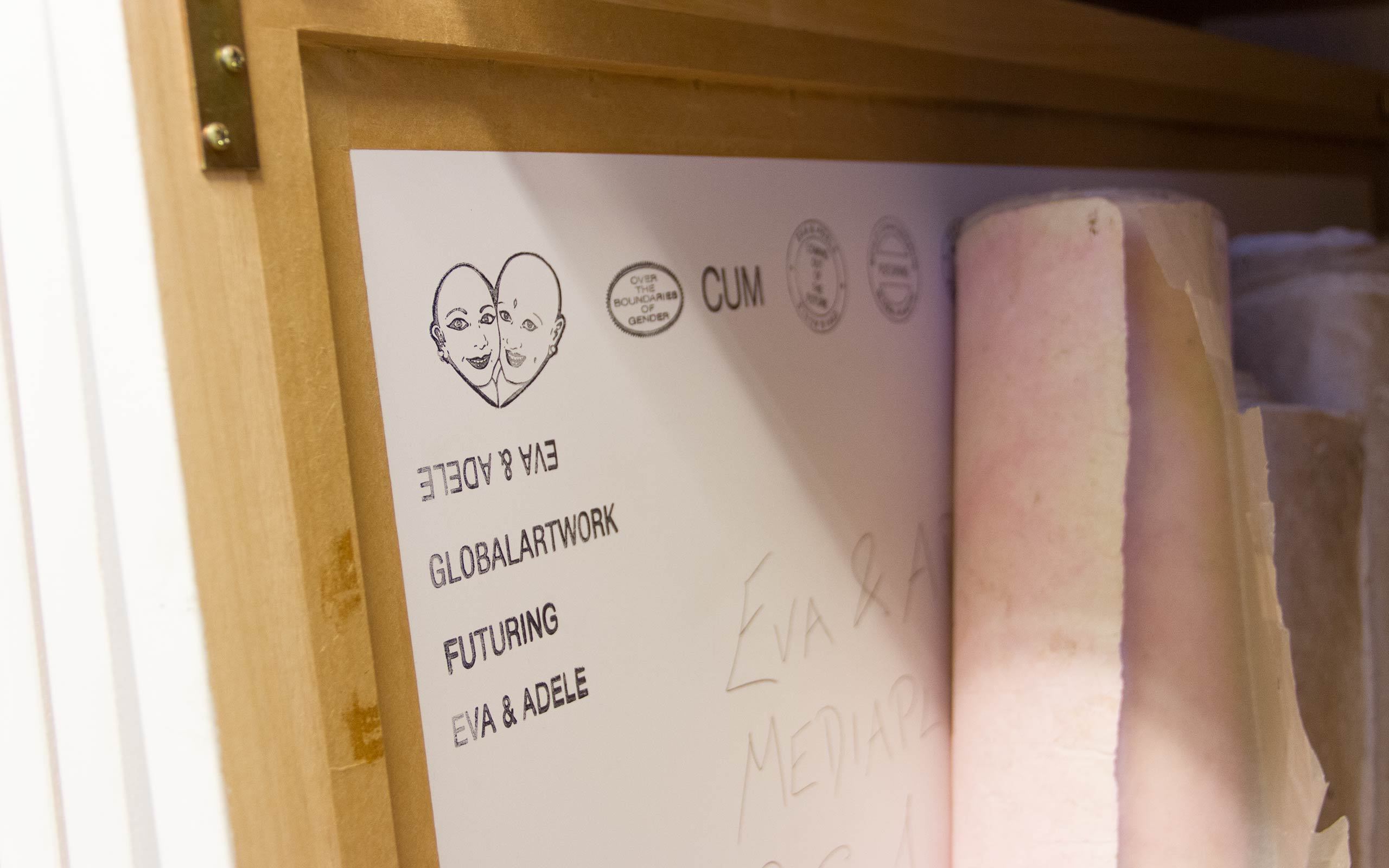
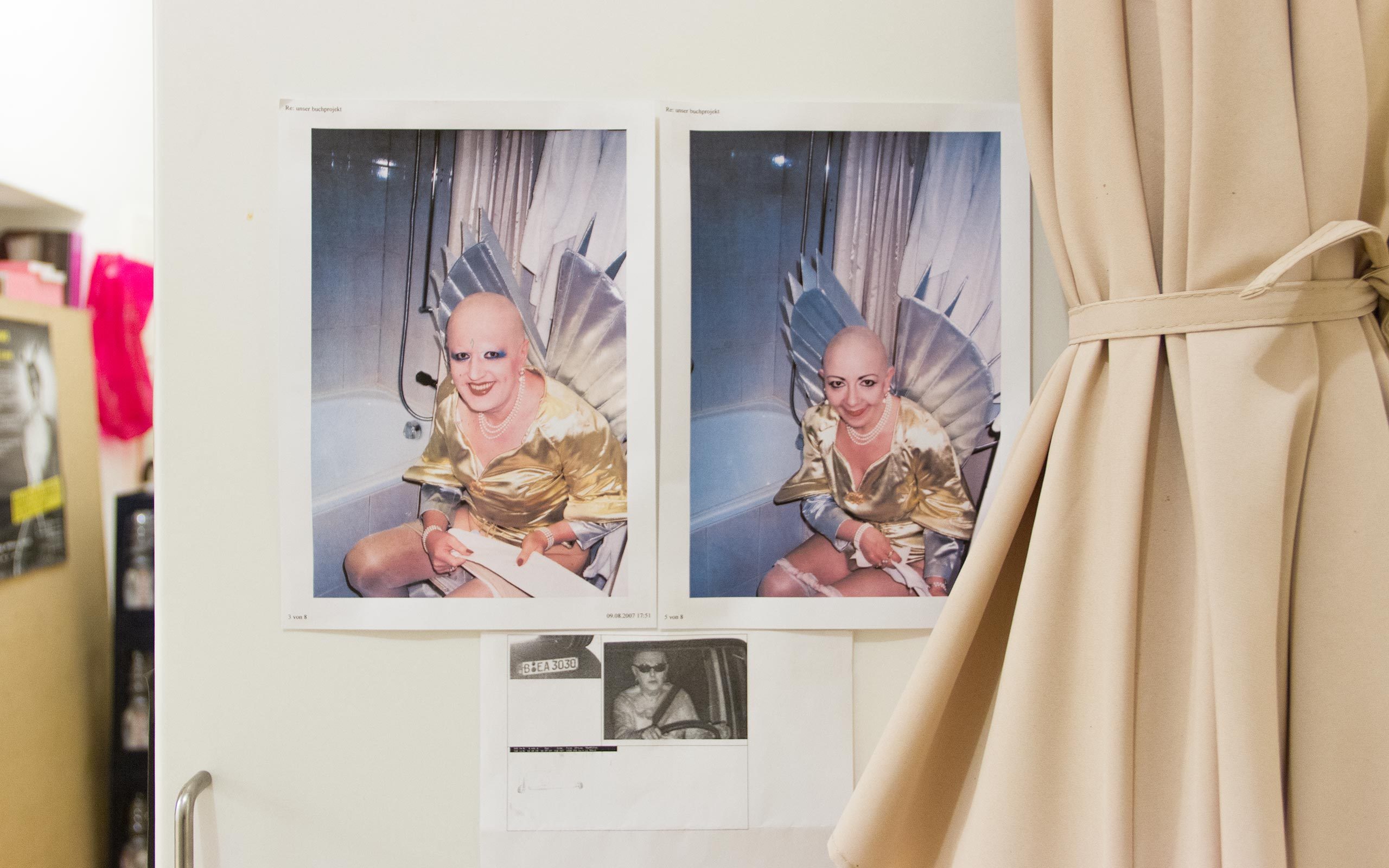
Do you have private days without the public?
A: Certainly, quite often. Sometimes we spend an entire week in the studio. We get fruit and vegetables and flowers and everything we need and often don’t even leave the house for five days.
E: Sometimes we try to concentrate entirely on painting, we don’t allow ourselves to be distracted. We are not at home, we are in the time machine.
We wouldn’t have thought it so. But as you have already mentioned you are not considered as being stage-struck.
A: No (laughs).
E: I believe many think that we are because we often take a cool position.
Who designs your clothes?
E: We do.
Is there actually a plan determining what you wear tomorrow or so?
A: Yes, we develop costume plans for each trip. Prior to our departure we know exactly what we’ll wear on which day: clothes, stockings, shoes, underwear, umbrellas, etc., everything is listed in the plan.
E: It is almost like a time schedule for students.
A: Exactly, it looks like a time schedule but it lists costumes, dates, events, and performances. Ten time schedules will be shown at the Museé d’Art Moderne de la Ville de Paris. The costume plans are drawings showing the invisible performative part of the work.
And you organize them yourself?
A: Yes, we have tried to always keep the same format and schedule, there is the front and the back with the contents of the suitcase. Deciding what to take is the hardest task before each trip. A true act, it takes hours and is eventually an artwork within an artwork.
Is every performance singular and unique?
A: No. The performances do repeat, however, we compose them differently.
E: We have to work economically.
A: It is important that for certain occasions we can move in a taxi, we have to live in these costumes, they are not stage costumes. Stage costumes are often made to look stunning but they are not practical. We live in our costumes; that’s the main difference.
That’s crazy. If you are really en route with such a schedule for an entire week you must have many suitcases.
A: We have quite a lot of luggage but we try to keep it economical. We don’t want to be laden down with luggage. We don’t want to be too heavily burdened.
E: Sometimes it is very hard, because the suitcases are heavy after all.
A: Sometimes we would need someone to pick us up directly at the gate and push our suitcases. Other artists may wish to travel, but for us it is always a really perfect performative act for which we prepare carefully. The preparation takes longer in hotel rooms. At home we have two bathrooms and can shave simultaneously and what is also very important to us is that we can do our makeup independently of each other.
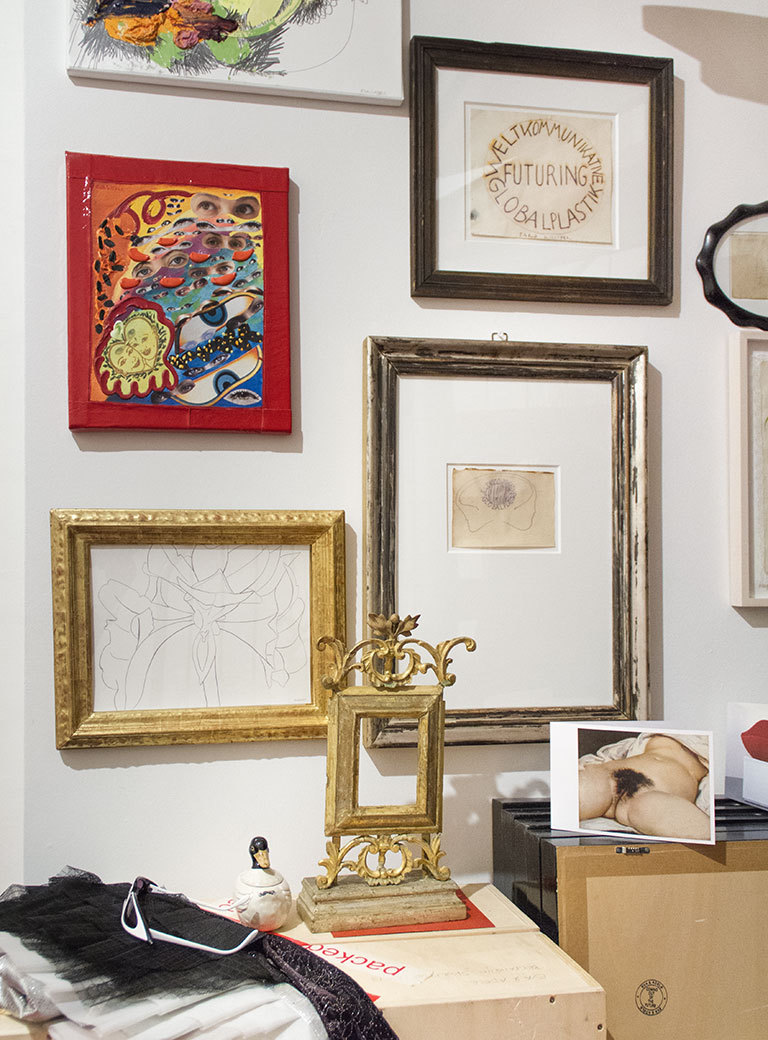
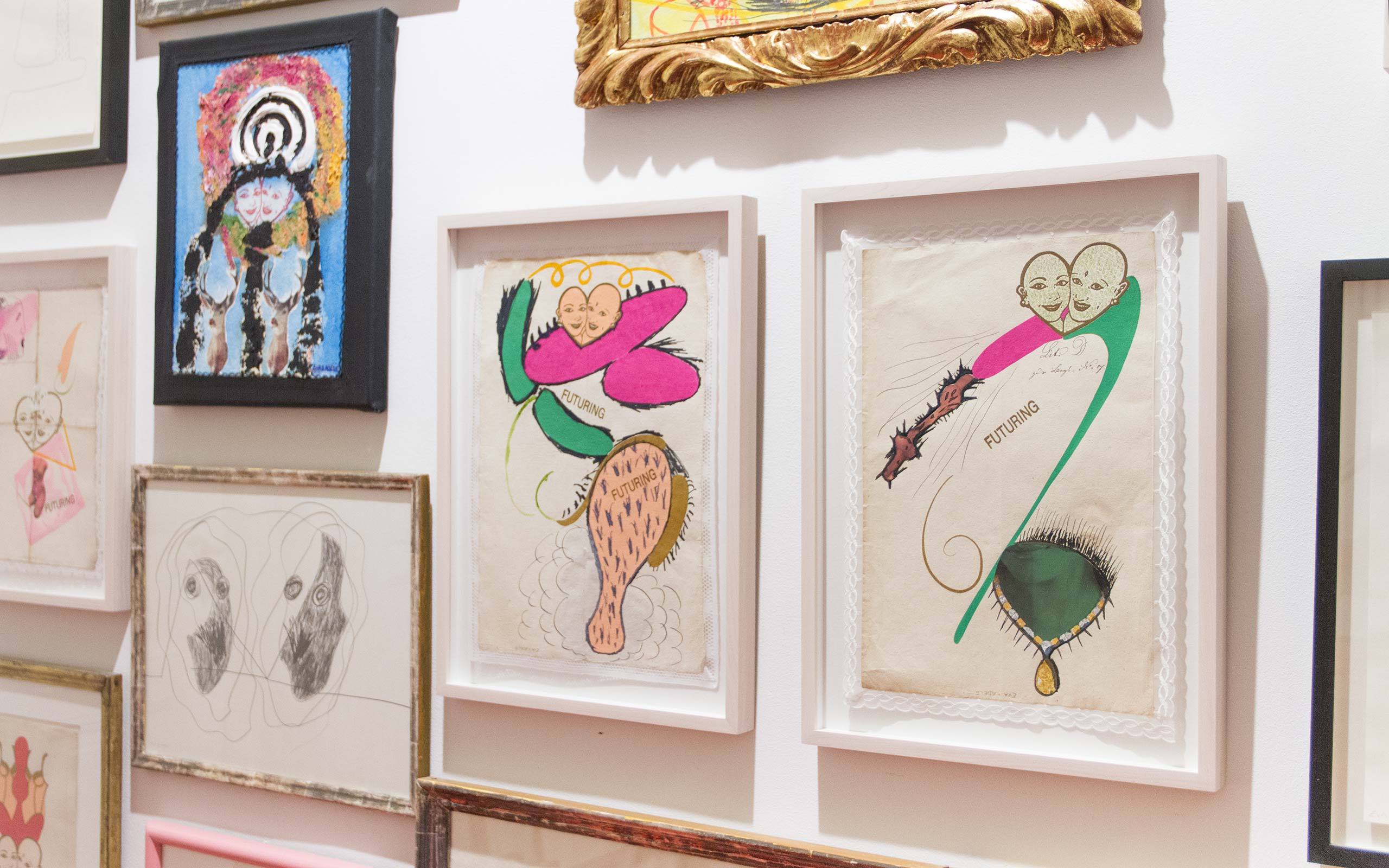
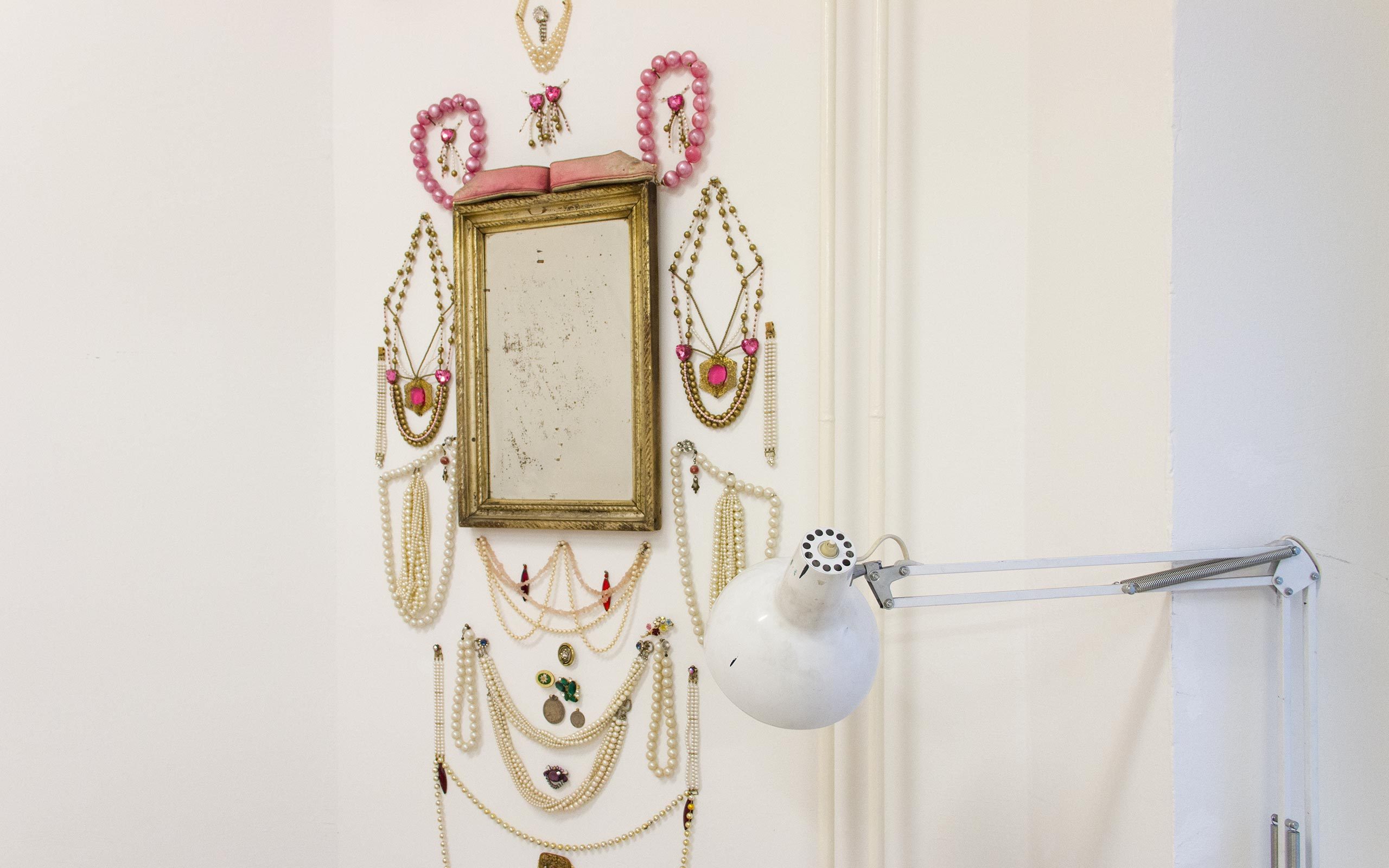
Is there anything the two of you are still dreaming of?
A: What we are dreaming of? I know something. When we’ve had our big show at the MOCAK Museum in Kraków Crakow focusing on the performative discourse, and when our most recent exhibition at the Marta in Herford concentrating on pencil drawings and early costumes has closed, when our predominantly early works will be shown with works from the collection at the Musée d’Art Moderne de la Ville de Paris, we would really like to have a big painting exhibition focusing entirely on the painterly aspect of our work. That would be fabulous.
E: It all started with a different kind of documentation, because the media and the photographers have collaborated so well. Every individual has contributed to the work. And because we made drawings from the mailed photographs or media images, the work moved further and further away from the artistic and traditional form of documentation towards abstraction and as much painterly freedom as possible. But at the same time, the performance must be present because we have a different background as classical painters. We would like to clarify this in our paintings; that our appearance is always there, that painting becomes performance.
A: Yes, every painting is at the same time also a performance.
E: We want to try to communicate the now and the future, because painting is the medium for duration and sustainability.
A: The most reflective media.
E: Yes, the formation process is a long process not only in our paintings but for all painters. It requires a lot of one’s lifetime, a large amount of thinking. On the other hand the performance, it is more ephemeral. Even though we have performed for such a long time and transformed our life into an artwork, it is still connected to our life, to our beating hearts.
A: That is true.
E: And, as Picasso once said, the wish to paint in order to fight death is always present. Painting is a medium that has this magic, perhaps because many have proclaimed painting dead, again and again wanting to eliminate and replace it through other media. But it has always returned assuming a new form. We stimulate painting today from the point of view of performance.
Can EVA & ADELE truly take a break, really come down, close the door?
A: We love to listen to music, we are great music lovers, for me music is the next best to painting. I don’t know if we’ll ever come down (laughs). I believe that is why retreating to our studio is so important, also the light here, we have very bright windows, we can walk around the rooms, walk down from upstairs and back. For a painter it is said that the larger the studio the better. Sometimes we stand enviously in the large halls of colleagues. And then we think: The space that we have functions rather well and is beautiful and sexy.
E: The space allows us a multidimensional artistic existence. The costumes are as important as the paintings, the drawings, and the makeup. For us it is not just putting on makeup but painting on our own faces.
How will it continue? Have you planned trips this year?
A: Yes, we’ll go to the Baltic Sea and draw. Afterwards will attend the Art Cologne and the Frieze New York. We just received an invitation from the Royal Academy of Arts London to participate in the summer exhibition. The curator, Richard Wilson, has invited the most important artist couples, they are the core. We’ll surely fly to London to attend Varnishing Day and the Blessing of the artists at St. James’s.
And certainly Paris, in September…
A: Exactly, our big solo exhibition will open September 29 at the Musée d’Art Moderne de la Ville de Paris. You Are My Biggest Inspiration will be shown until the end of February 2017. Later in 2017 it continues with the solo exhibition The Beauty of Madness by Thomas Olbricht in the me Collectors Room in Berlin. But prior to that we’ll show two of our big Paintingsculptures at the viennacontemporary at gallery Artelier Contemporary .
Will EVA & ADELE ever retire?
A: No, we’ll continue to the bitter end (laughs). To be more precise, until we’ll go back to the future.
E: Then our artistic legacy has to continue.
A: Yes, we have prepared a will that determines that a foundation shall be established, the form of which has already been worked out. The foundation will inherit everything and continue as EVA & ADELE.
That’s beautiful. Then you’ll be temporarily traveling to the future.
A: Exactly, we’ll travel into the future and the foundation remains here for the time being and work. These things are important for the protection and conservation of the work.
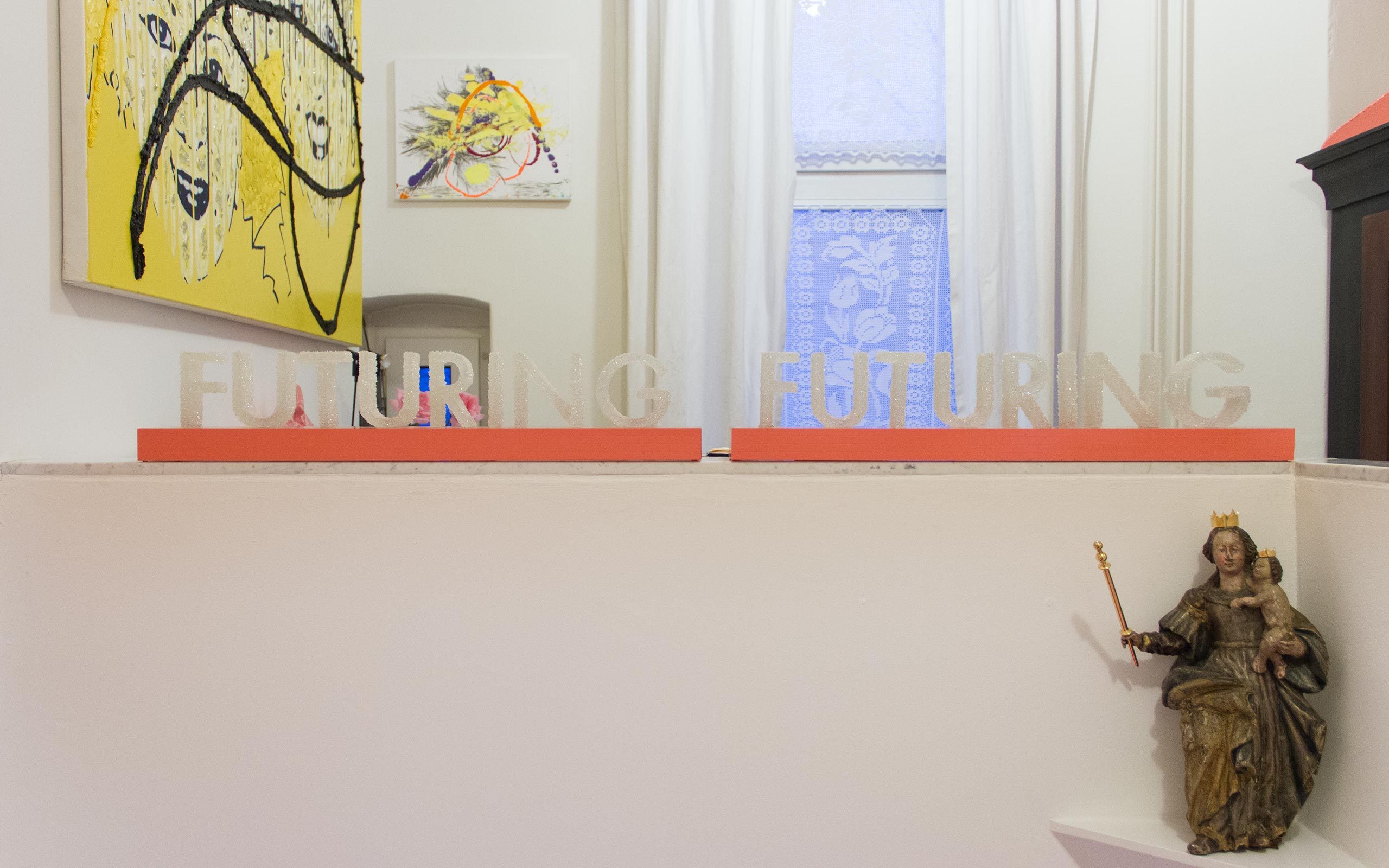
Interview: Michael Wuerges
Photos: Florian Langhammer


